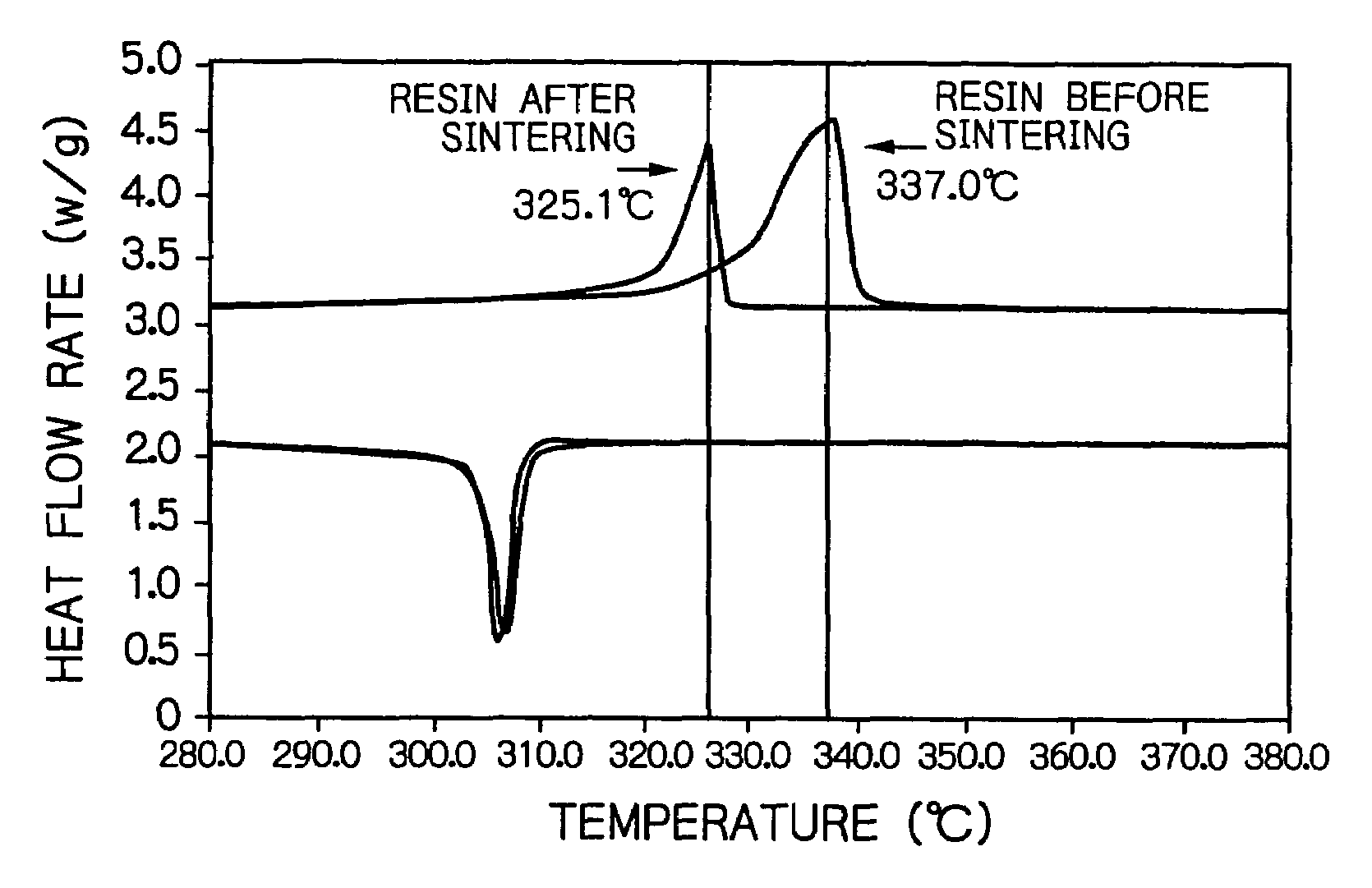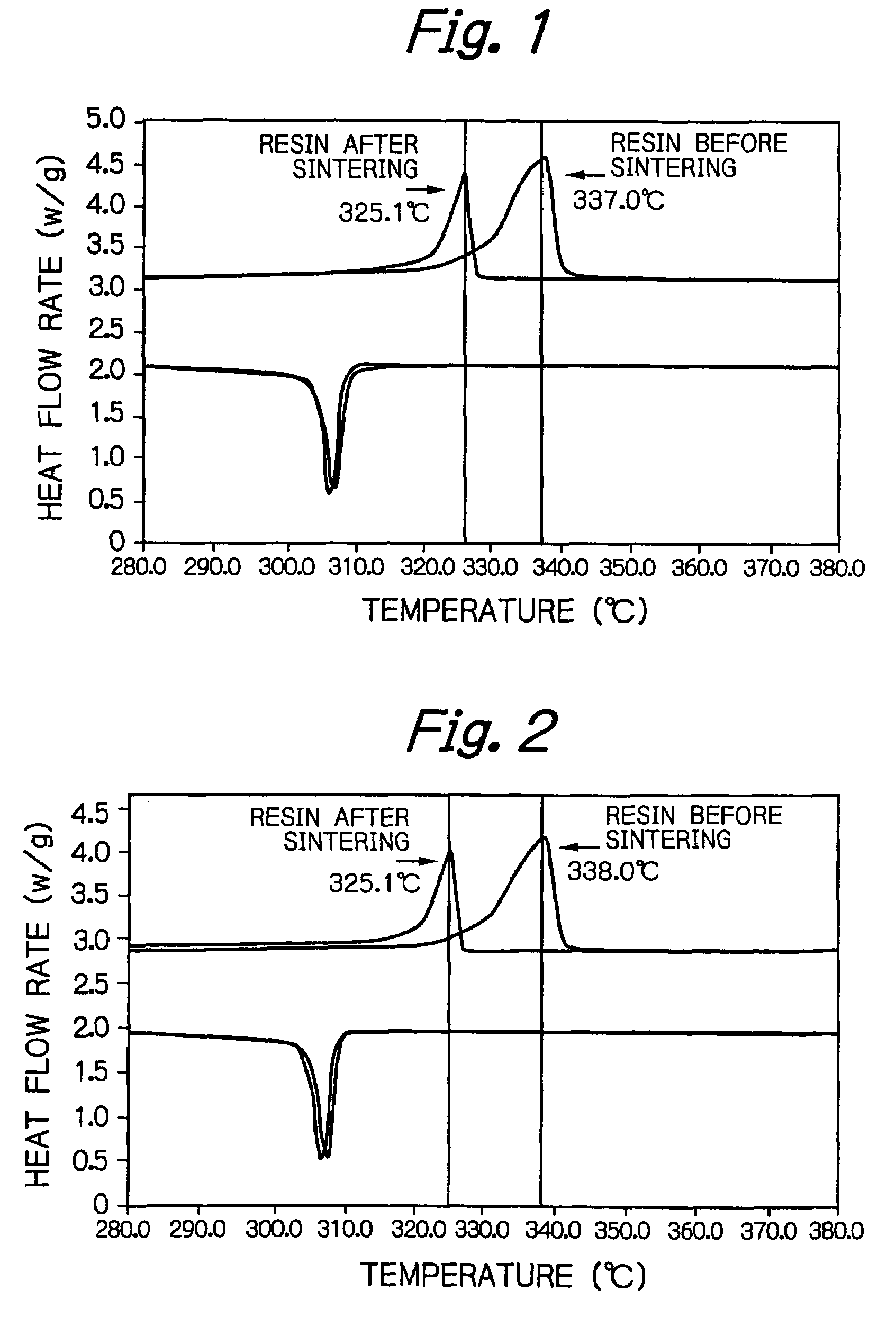Radiation-modified poly (tetrafluoroethylene) resin feeds and a process for producing the same
a technology of tetrafluoroethylene and resin feed, which is applied in the field of improving the thermal properties of poly (tetrafluoroethylene) resin feed, can solve the problems of affecting the quality affecting the moldability of poly(tetrafluoroethylene) resin feed, and deteriorating various characteristics of their molding, so as to improve the moldability and the effect of reducing the number of defects
- Summary
- Abstract
- Description
- Claims
- Application Information
AI Technical Summary
Benefits of technology
Problems solved by technology
Method used
Image
Examples
example 1
[0021]A commercial fine powder of poly(tetrafluoroethylene) resin prepared by emulsion polymerization (CD 090 of Asahi Glass Fluoropolymers Co., Ltd.) was used as a resin feed and put into paper envelopes. The respective samples were irradiated with γ-rays for 0.5, 2.5 and 5 hours at a dose rate of 200 Gy / h in air at room temperature, thus producing feed powders treated with γ-rays to absorbed doses of 100, 500 and 1,000 Gy.
[0022]Differential scanning calorimetry (DSC) provides a simple tool for examining thermal properties of the poly(tetrafluoroethylene) resin both before sintering (in an unirradiated state) and after molding (in an irradiated state). The first run of scan with temperature elevation simulates thermal properties after polymerization reaction whereas the second run of scan with temperature elevation simulates thermal properties after molding.
[0023]Thermal properties of the feed powder irradiated with 500 Gy of γ-rays were measured by DSC in a temperature range of 27...
example 2
[0027]A commercial molding powder of poly(tetrafluoroethylene) resin prepared by suspension polymerization (G 163 of Asahi Glass Fluoropolymers Co., Ltd.) was used as a resin feed and put into paper envelopes. The respective samples were irradiated with γ-rays for 1, 3 and 5 hours at a dose rate of 100 Gy / h in air at room temperature, thus producing feed powders treated with γ-rays to absorbed doses of 100, 300 and 500 Gy.
[0028]The feed powders treated with γ-rays to absorbed doses of 100, 300 and 500 Gy were subjected to the first and second runs of DSC in a temperature range of 270–390° C. with the temperature rising at a rate of 10° C. / min and the melting temperature and the quantity of heat of fusion were measured for each sample; the results are shown in Table 2.
[0029]In the first run of DSC, the irradiated feed powders exhibited lower melting temperatures than the unirradiated sample but there was little change in the quantity of heat of fusion. In the second run of DSC, there...
example 3
[0031]A commercial molding powder of poly(tetrafluoroethylene) resin prepared by suspension polymerization (G 350 of Asahi Glass Fluoropolymers Co., Ltd.) was used as a resin feed and put into paper envelopes. The respective samples were irradiated with γ-rays for 12, 30 and 60 minutes at a dose rate of 1,000 Gy / h in air at room temperature, thus producing feed powders treated with α-rays to absorbed doses of 200, 500 and 1,000 Gy.
[0032]The feed powders treated with γ-rays to absorbed doses of 200, 500 and 1,000 Gy were subjected to the first and second runs of DSC in a temperature range of 270–390° C. with the temperature rising at a rate of 10° C. / min and the melting temperature and the quantity of heat of fusion were measured for each sample; the results are shown in Table 3.
[0033]In the first run of DSC, the irradiated feed powders exhibited lower melting temperatures than the unirradiated sample but there was little change in the quantity of heat of fusion. In the second run of...
PUM
| Property | Measurement | Unit |
|---|---|---|
| temperature | aaaaa | aaaaa |
| temperature | aaaaa | aaaaa |
| temperature | aaaaa | aaaaa |
Abstract
Description
Claims
Application Information
 Login to View More
Login to View More - R&D
- Intellectual Property
- Life Sciences
- Materials
- Tech Scout
- Unparalleled Data Quality
- Higher Quality Content
- 60% Fewer Hallucinations
Browse by: Latest US Patents, China's latest patents, Technical Efficacy Thesaurus, Application Domain, Technology Topic, Popular Technical Reports.
© 2025 PatSnap. All rights reserved.Legal|Privacy policy|Modern Slavery Act Transparency Statement|Sitemap|About US| Contact US: help@patsnap.com


